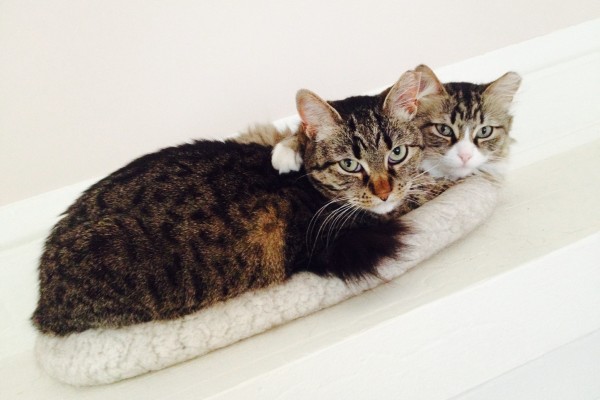June 10, 2015
After trapping, spaying, and vaccinating our two feral cats, we decided to let them continue to be happily fed and sheltered outdoor cats. Mama and Tommie quickly made themselves comfortable in our backyard, hanging around at breakfast and dinner times in anticipation. In order to help socialize them, we learned to sit with them while they ate so that they would make the positive connection between getting fed and being around people. They eventually began to respond to a whistle command when we had a meal ready for them. Feral cats do continue to hunt for food (rodents, birds); however, the more regularly they are fed by their human caretakers, the less they need to hunt and the more bonded to their human companions they become.
We constructed a shelter for them to stay warm and dry. There are many different methods floating around on the internet, but the easiest and most common option is to take a standard 18-gallon rubbermaid storage container, cut a hole in one end, and line the inside with sheets of styrofoam or a styrofoam cooler. The remaining space is filled in with hay or shredded newspaper for additional insulation. Instructions for this kind of shelter can be found here.
We added a “Snugglesafe” heating pad, which is warmed up in the microwave and can retain and release heat slowly over the course of several hours, to help keep the kitties warm in the brutal Chicago winter.
Mama and Tommie started to become well known around our block, and they even sometimes joined us when walking our dog. The neighbors found this shambling crew of humans and beasts hilarious! We would often get stopped by people who had questions about feral cats, so we took the time to explain that they were happy, healthy, and cared for. And they were–they spent most of their time lounging on our lawn furniture or basking in the sun on the roof of our garage. The rodent population in our alley became nonexistent; however, we also had to stop feeding the songbirds because we didn’t want to invite them into the small critter death trap that our yard had become. We became quite attached to these cats, and despite the fact that they wouldn’t sit in our laps or let us handle them, they felt like our pets.
One fall evening, after more than a year of being happy outdoor cats, neither cat showed up for dinner. It was very unusual for them. We saw them swatting a dead bug around earlier in the day, and they hadn’t both missed a meal in months. Usually by this time of day, they were both sitting on the window sill looking in at us until we put their dishes out. We whistled. We left the food out in case they came by later. Breakfast rolled around and no cats were in the window, their dinner still sitting out. Now we started to worry. We called around to all the shelters to see if their microchips had been reported. We posted flyers around the neighborhood and asked all the neighbors who knew about our outdoor cats if they had seen them. No luck. We even went down to Animal Care and Control to see if they were waiting in the holding period before getting sent to euthanasia. Early on we had conversations about the fact that, as wild animals, they would eventually stop coming around, but we weren’t prepared for this. We guessed that someone saw them, thought they were strays, and trapped them to either keep as pets or take in to a shelter. We feared the worst as days went by with no sign of them.
 Then, after about three weeks, Tommie stalked up to the back door, wary as ever, wondering where dinner was. We were thrilled! But we were so curious about what had happened to her, and where was Mama? Did they find a new yard to live in? Was someone else feeding them? Did they decide to part ways or find new territory? Tommie was even more standoffish than usual after her return, and she came around for meals but dashed off immediately after finishing her last morsel.
Then, after about three weeks, Tommie stalked up to the back door, wary as ever, wondering where dinner was. We were thrilled! But we were so curious about what had happened to her, and where was Mama? Did they find a new yard to live in? Was someone else feeding them? Did they decide to part ways or find new territory? Tommie was even more standoffish than usual after her return, and she came around for meals but dashed off immediately after finishing her last morsel.
A few weeks later, Mama returned to the backyard for dinner. She was there at the back door, looking sick and emaciated; she had lost half her body weight. Wherever she was, she was not being properly cared for. She walked right into the house as if to say “I’m an indoor cat now.” We slowly nursed her back to health. Before winter returned, we rented another trap from Treehouse and brought Tommie inside to reunite with Mama. They have lived inside with us since, mostly keeping a distance, but growing more and more friendly over time. It has been a lot of slow and patient work to socialize them, and even though they still don’t climb in our laps, we are so happy to have them as a part of our lives.
For more information on feral cats and the Trap-Neuter-Return program, please visit Treehouse Cats and Alley Cat Allies.
Nick manages our dog walking team at Rover-Time. He lives with his wife in Albany Park and together they share one Australian cattle dog mix named Squirrely, a parakeet named Pierre, and two cats who were originally feral but later came to live inside and become socialized.

Recent Comments